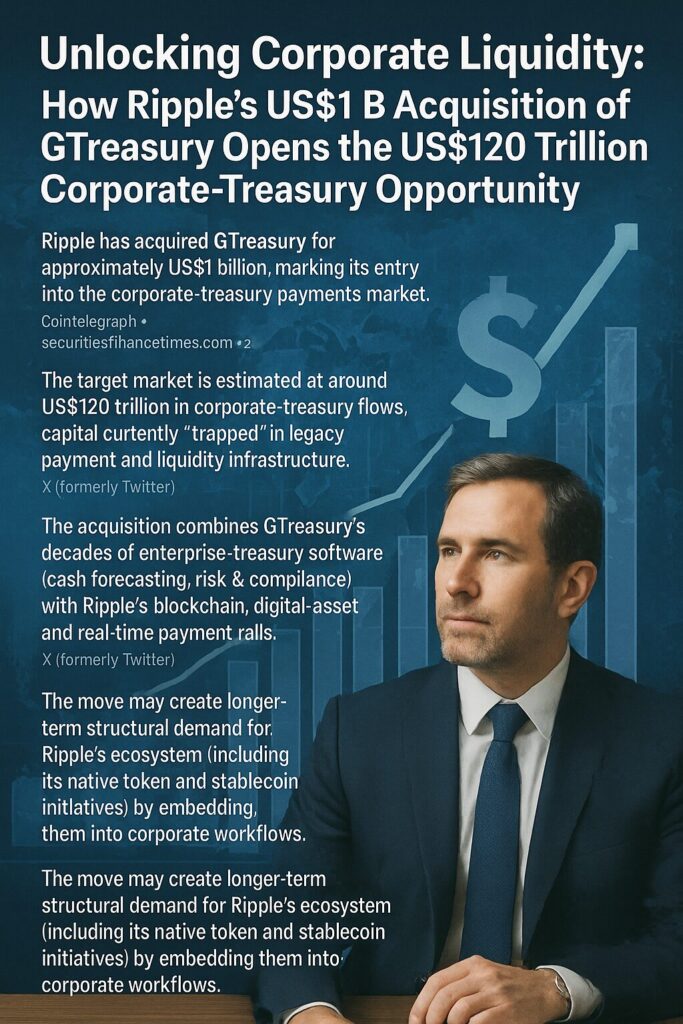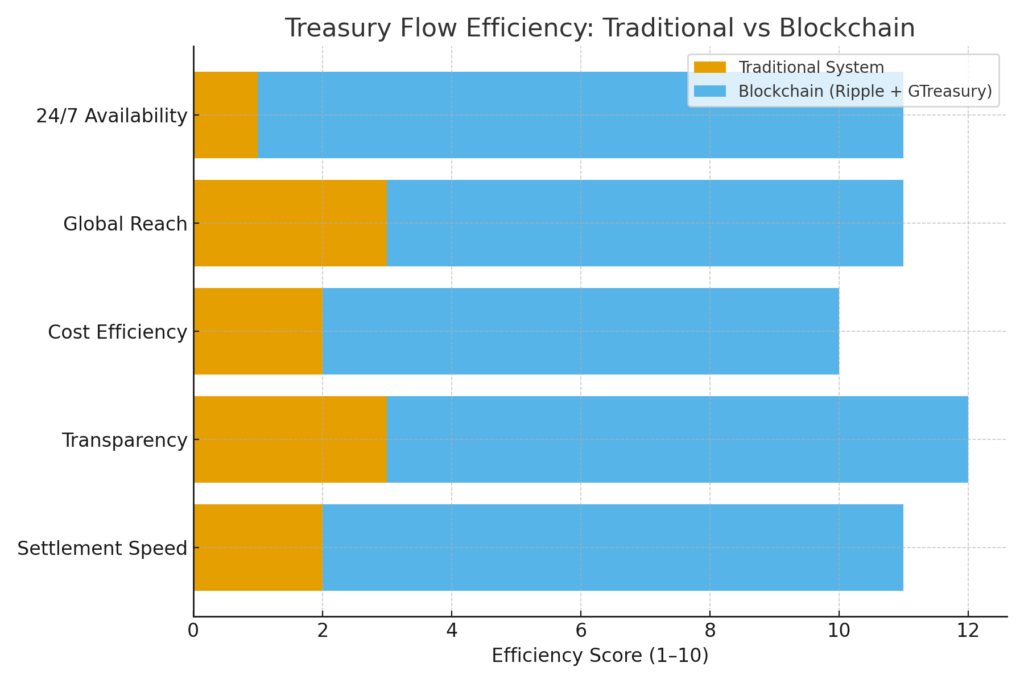
Main Points :
- Ripple has acquired GTreasury for approximately US$1 billion, marking its entry into the corporate-treasury payments market.
- The target market is estimated at around US$120 trillion in corporate-treasury flows, capital currently “trapped” in legacy payment and liquidity infrastructure.
- The acquisition combines GTreasury’s decades of enterprise-treasury software (cash forecasting, risk & compliance) with Ripple’s blockchain, digital-asset and real-time payment rails.
- For new crypto-asset and blockchain-practical-use readers: this is a signal of digital-assets shifting from speculative token plays to real-world infrastructure in global corporate finance.
- The move may create longer-term structural demand for Ripple’s ecosystem (including its native token and stablecoin initiatives) by embedding them into corporate workflows.
1. The Deal at a Glance
In October 2025, Ripple announced it would acquire GTreasury for about US$1 billion. GTreasury is a well-established treasurymanagement-systems (TMS) firm serving over a thousand global clients and handling large corporate cash-flows.
Ripple’s CEO, Brad Garlinghouse, framed the move as “breaking into the US$120 trillion corporate-treasury payments market” and freeing “trapped capital” from slow, outdated systems.
For readers scouting new crypto assets or infrastructure plays: this is not just about cross-border payments or retail crypto adoption. It is about embedding blockchain and digital-asset tools into the highest-level corporate finance workflows.
2. Why Corporate Treasury Matters for Crypto / Blockchain

2.1 A massive market: US$120 trillion in flows
The Zahl is enormous: corporate treasuries around the world manage literally tens of trillions of dollars in payments, cash flows, risk exposures, liquidity across geographies. Legacy infrastructures — slower settlement, fragmented rails, manual processes — lock up large sums of capital and create inefficiencies.
For the blockchain-and-crypto ecosystem, this means the potential addressable market is far beyond retail trades or speculative tokens. If blockchain can be adopted at the enterprise treasury level, the volume and impact could be transformative.
2.2 Trapped capital + inefficient rails = opportunity
According to Ripple’s messaging, large amounts of capital are “stuck” in antiquated payment and liquidity systems — creating cost, friction, barriers to entering new markets.
For a developer or practitioner thinking about blockchain utility: this means that real world enterprise pain-points exist — cash forecasting, FX risk, inter-company payments, idle liquidity yielding nothing — which blockchain + tokenization + real-time settlement may address.
2.3 Digital assets migrating from speculation to infrastructure
The acquisition signals an evolution: digital assets (stablecoins, tokenised deposits, blockchain rails) are being positioned not just as speculative plays, but as fundamental infrastructure for corporate payments, liquidity management and treasury operations. GTreasury’s clients will now gain access (via Ripple) to tools for stablecoins, tokenised deposits, real-time cross-border payments and access to repo-markets for short-term yield.
If you are exploring new crypto assets or projects: look for those that move beyond “token listing” and instead target large enterprise workflows, liquidity management, treasury operations — that’s where the scale lies.
3. What GTreasury Brings to the Table
GTreasury is not a startup. It has decades of experience in enterprise treasury systems: cash forecasting, risk management, FX operations, compliance and audit frameworks across large corporates.
Key capabilities include:
- Managing global cash positions and forecasting across subsidiaries
- Inter-company payments and liquidity pooling
- FX risk management and hedging tasks
- Compliance, audit trails, enterprise-grade treasury systems
This foundation gives Ripple a bridge into corporate finance workflows. Rather than building everything from scratch, Ripple now has ready-made enterprise clients and infrastructure to integrate blockchain/digital-asset capabilities into real finance teams.
4. What Ripple Gains (and What It Means for the Ecosystem)

4.1 Enterprise client base & scale
By acquiring GTreasury, Ripple gains access to a network of large corporates (Fortune 500, global enterprises) already using GTreasury’s platform. This provides real-world use-cases and on-ramps for blockchain solutions in treasury operations.
4.2 Integration of blockchain + treasury workflows
Ripple will integrate its blockchain rails (real-time settlement, tokenised assets, stablecoins) with GTreasury’s software backbone. This enables corporations to:
- Move money 24/7/365 globally with blockchain
- Manage stablecoins or tokenised deposits alongside fiat
- Unlock idle capital by accessing short-term yield via prime brokerage (e.g., via Hidden Road, another Ripple acquisition)
4.3 Potential structural demand for digital asset infrastructure & tokens
For those watching crypto-assets, one implication is: as corporates adopt treasury infrastructure built on blockchain, demand may grow for tokens that underlie those rails (e.g., Ripple’s native token or stablecoin). While not guaranteed, embedding tokenised assets in corporate workflows is a meaningful step up from purely retail speculation. Analysts have noted this deal as a structural boost for Ripple’s ecosystem.
4.4 Competitive positioning vs legacy systems
The acquisition positions Ripple as a direct challenger to legacy payment rails and treasury workflows (including systems like SWIFT). Commentators frame it as “attack on legacy rails” and a pivot from pure crypto to institutional finance.
5. Implications for Investors, Blockchain Practitioners and Crypto-Asset Seekers

5.1 For crypto-asset investors seeking next growth areas
- Traditional narratives focussed on retail DeFi or metaverse games may be limiting. This deal shows that enterprise infrastructure is a major emerging battleground.
- Assets and projects that link into enterprise treasury, stablecoins, tokenisation, corporate liquidity flows may merit attention.
- However, note: enterprise adoption takes time (integration, regulation, client onboarding) — this is a long-horizon play, not necessarily a quick trade.
5.2 For blockchain / wallet / infrastructure developers (and for your wallet project)
Given your interest in non-custodial wallets with swaps (BTC→ETH) and transparent UX, consider these take-aways:
- Corporate treasuries will likely demand robust audit trails, compliance integration, real-time settlement visibility. Your wallet UX should account for institutional-grade transparency and auditability.
- Connecting retail blockchain tooling to enterprise workflows may require interoperability (stablecoins, tokenised deposits, cross-chain swaps).
- Provide option for real-time settlement, access to yield (repo, idle capital) or tokenised liquidity for institutional users.
- Monitoring large-scale flows: look at how tokenised cash and stablecoins flow through corporate treasuries — this can be a differentiation for your wallet (or associated services).
5.3 For corporate treasurers and finance teams
- If you are in treasury management: evaluate how blockchain / tokenisation can unlock idle cash, reduce FX risk, speed settlement, access new-yield markets.
- Understand the regulatory and compliance overlay: integrating stablecoins or tokenised deposits requires architecture, audit, risk management. GTreasury’s background gives confidence to corporates adopting this direction.
- Treasury teams should look at partnerships between TMS providers and blockchain firms as signal of the evolving landscape.
6. Risks & Considerations
- Though the deal is officially announced, integration risk remains: software compatibilities, client migration, regulatory approvals. Many enterprise projects take longer than expected.
- The immediate effect on token prices (e.g., Ripple’s token) may be muted or delayed: enterprise adoption does not always equate to immediate demand for the token underlying the infrastructure. Some analysts caution that benefits may accrue to the ecosystem but not directly to speculative token holders.
- Regulation remains a key factor: Institutional adoption of stablecoins and tokenised deposits is still heavily influenced by regulatory clarity in each jurisdiction. If regulation lags, rollout may slow.
- Legacy incumbents may respond: Payment networks and treasury system vendors will likely accelerate their own blockchain strategies. Ripple is not guaranteed a monopoly in this space.
7. Recent Trends & What to Watch
- Ripple has multiple major acquisitions in 2025: Hidden Road (prime brokerage) and Rail (stablecoin infrastructure) preceded GTreasury. This shows a deliberate build-out of an end-to-end enterprise-digital-asset stack.
- On the crypto-asset side: Ripple’s ecosystem (including its stablecoin, tokenised assets) is being positioned for enterprise adoption. Example: its US dollar stablecoin (RLUSD) passed US$840 million in supply; corporate clients may start using such stablecoins for payments and deposits.
- Industry-wide: Traditional financial institutions are increasingly exploring blockchain and tokenisation of assets (cash, deposits, securities). As such, players like Ripple benefit from first-mover advantage in enterprise blockchain.
- What to monitor next:
- Closing of GTreasury acquisition and full client migration.
- Announcement of corporate clients using Ripple+GTreasury platform for treasury operations (e.g., stablecoin deposits, tokenised cash, real-time cross-border payments).
- Token flow and demand impact: whether Ripple’s token or stablecoin usage increases significantly in corporate treasury operations.
- Regulatory moves: especially those pertaining to stablecoins, tokenised deposits, corporate treasury digital-assets.
- Competitive responses: how legacy TMS vendors or payment networks adapt or partner with crypto/blockchain firms.
8. Conclusion
The acquisition of GTreasury by Ripple is much more than a headline crypto deal. It represents a strategic shift: from blockchain firms targeting retail payment or speculative asset flows, to going deep into the heart of corporate finance — treasuries, liquidity, cash flows, risk, global settlement. With an addressable market estimated at US$120 trillion, this move signals where the next wave of crypto-asset and blockchain infrastructure value might lie.
For investors and practitioners seeking new crypto assets or blockchain-based practical systems, the message is clear: watch infrastructure plays that plug into real-world finance and treasury operations. For your wallet project and non-custodial design, this means thinking not just in terms of retail swaps, but also about how your system can interface (now or in future) with enterprise assets, tokenised deposits, yield-bearing instruments, sanity in audit/compliance and transparency.
In short: the next frontier of crypto isn’t just decentralised finance for individuals — it’s decentralised, digital-asset enabled finance for corporations. The Ripple-GTreasury deal may be one of the first major steps in that direction.

